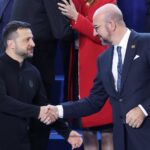The central theme of the Poland’s upcoming presidency of the European Council will be security, a Polish official confirmed this week.
Framed across seven key pillars: external, energy, economic, food, climate, health and information, this comprehensive approach aims to address Europe’s most pressing challenges during the six-month presidency, which begins on January 1, 2025.
Speaking at a meeting of the European Economic and Social Committee in Warsaw, Magdalena Sobkowiak-Czarnecka, Polish undersecretary of state for European Union Affairs, made it clear that the presidency would try to adopt an approach that combined climate goals and economic competitiveness, which could not afford to be at odds with each other.
“Security is our motto, and this will be the focus of our presidency,” she said. “However, this catalogue of pillars is not closed.
“We will be very much open to dialogue, and security will also relate to civil society and to increasing citizens’ resilience. For this reason, we will set up two committees within the prime minister’s office to constantly listen to NGOs and entrepreneurs.”
Also at the meeting was EESC president, Oliver Röpke, who stressed the critical importance of reimagining security in a world defined by rapid change and complex challenges:
“From safeguarding our physical and digital landscapes to protecting the values that unite us as Europeans, it is clear that security is not merely a defensive posture; it is a proactive commitment to resilience, cooperation, and trust,” he said.
“Poland’s upcoming presidency comes at a time when Europe is facing many challenges, but also many opportunities.”
Priorities
Specifically, the Polish EU presidency is expected to work on addressing the ongoing war in Ukraine, financing the ‘East Shield’, and fostering a robust European defence industry.
On energy security, it will reduce reliance on external energy sources, accelerating the energy transition with European-led technologies, and lowering energy costs.
Warsaw also wants to reform the EU’s Multiannual Financial Framework, increasing the availability of European funds for beneficiaries and strengthening cohesion policy. Its slogan for this initiative will be, ‘more power to regions, less power to Brussels’.
On food and climate security, Poland aims to bridge the gap between agriculture and climate activism, with a commitment to competitiveness and a practical climate framework.
In health, strengthening EU independence in medicine production and addressing mental health challenges, especially among children and youth, will be priorities.
Security of information will also be given attention, notably combating disinformation, improving cybersecurity, and managing the impact of virtual reality on mental health, particularly for younger generations.
Digital transformation
While security will unquestionably, and understandably, be the key priority of the Polish presidency, business groups have been calling on Warsaw to ensure that Europe’s competitiveness is boosted by renewed focus on the bloc’s digital transformation.
Last month, a group of leading technology companies urged the incoming Polish presidency to enable them to grasp Europe’s digitalisation opportunity and spearhead its return to competitiveness on the global stage.
Senior representatives from Ericsson, IBM, Intel, Nokia and Vodafone, called on Poland to use the presidency to drive a renewed approach to incentivise investments in the digital sector.
Political momentum is gathering following reports by former Italian prime ministers Enrico Letta and Mario Draghi advocating for changes to improve the EU’s faltering competitiveness. The reports warn that the EU is falling behind the US and China on multiple counts.
“Europe’s focus must be on leading the industrial internet globally by investing in and leveraging emerging technologies like enterprise AI, quantum computing and 5G standalone connectivity,” said Robert Condon, head of Ericsson’s government and policy advocacy in Europe.
“Collaboration between member states, the EU, and industry is essential to drive the deployment of top-tier digital infrastructure, adopt productivity-boosting tools for driving green, secure and digital transformation across industry sectors.”
Areas highlighted for critical intervention include research investment, the deployment of digital infrastructure including 5G and fibre networks, and the development of emerging technologies such as AI.
Last week, another group, the Computer and Communications Industry Association (CCIA Europe), published nine key recommendations on how Poland can boost EU tech competitiveness and accelerate Europe’s digital transformation during its presidency.
Amongst others, CCIA Europe calls for the elimination of internal trade barriers that continue to fragment the EU market, as well as for better cross-border opportunities for digital firms.
The sector highlights the need to craft EU tech laws that are consistent from the outset. Digital policies must be grounded in actual market dynamics, but also need to respect fundamental principles, such as net neutrality and the EU’s ban on general monitoring.
For instance, the Polish Presidency must ensure that the forthcoming Digital Networks Act (likely in the Commission’s 2025 work programme) includes unwavering guarantees that Europeans can continue to access the open internet and avoids unnecessary regulatory intervention—whether it is network fees or some mandatory arbitration mechanism.
CCIA Europe says that its recommendations provide the Polish presidency with an actionable roadmap that balances the need for regulatory consistency with the importance of fostering a dynamic and globally competitive digital economy across the European Union.
“The Polish EU presidency plays a crucial role in shaping Europe’s digital future,” says Senior Vice President and Head of CCIA Europe, Daniel Friedlaender. “Together with the new European Parliament and Commission, Poland can reset the direction of EU digital policy for years to come – finally ushering in a shift from tech regulation to innovation.
“CCIA Europe’s recommendations focus on fostering tech innovation, simplifying the implementation of digital regulations, and removing internal barriers to digital trade – all of these are key to ensuring the EU remains globally competitive.”
Europe still awaits its new Commission
The agenda-setting presidency of the European Council is held by each member state for six months on a rotating basis. This will be the second time that Poland has held the presidency since it became an EU member in 2024.
The current, Hungarian presidency, has largely been ineffective, hampered by Budapest’s isolation within the EU over its stance towards Russia’s war on Ukraine—Prime Minister Viktor Orbán is viewed as being too close to Moscow—and by the election of a new European Parliament.
The new European Commission has also yet to be approved. While MEP’s have nodded through 19 of Commission President Ursula von der Leyen’s 26 commissioners, they have yet to decide on the fate of Hungary’s Olivér Várhelyi and the six executive vice presidents (Kaja Kallas, Raffaele Fitto, Roxana Mînzatu, Stéphane Séjourné, Teresa Ribera and Henna Virkkunen).
Originally expected to start work on December 1, it could now be 2025 before the new commissioners assume office.







